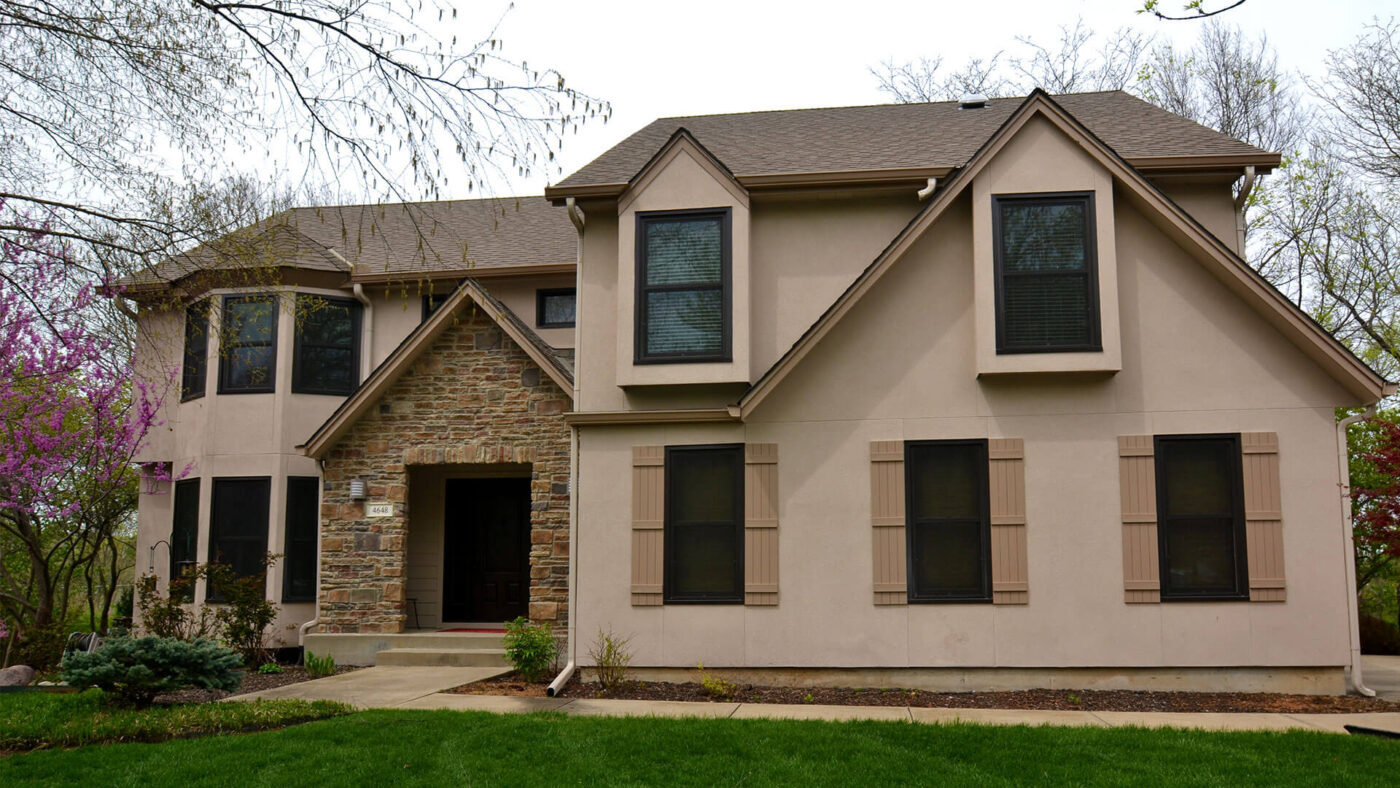Exploring the Beauty of Stucco and Siding Houses

Stucco and siding houses have become synonymous with elegance and durability in residential architecture. This captivating journey delves into the world of stucco and siding, shedding light on their importance and impact on modern home design.
As we unravel the intricacies of stucco and siding finishes, materials, installation processes, and maintenance tips, readers will gain a deeper understanding of how these elements contribute to the overall aesthetic and functionality of a house.
Introduction to Stucco and Siding Houses
Stucco and siding are common materials used in residential architecture to enhance the exterior of houses. Stucco is a mixture of cement, sand, and water that is applied in layers to create a smooth, durable finish. On the other hand, siding refers to the protective material installed on the exterior walls of a building.
Purpose of Stucco and Siding
Stucco and siding serve multiple purposes when used on houses. They provide protection against the elements, such as rain, wind, and sunlight, helping to maintain the structural integrity of the building. Additionally, stucco and siding can improve the insulation of a house, reducing energy costs by keeping the interior temperature stable.
Benefits of Choosing Stucco and Siding
- Enhanced Durability: Stucco and siding are long-lasting materials that require minimal maintenance, making them a cost-effective choice for homeowners.
- Versatility: Both stucco and siding come in a variety of colors and textures, allowing homeowners to customize the exterior of their houses to suit their preferences.
- Increased Curb Appeal: Stucco and siding can significantly enhance the aesthetic appeal of a house, increasing its overall value and attractiveness to potential buyers.
- Weather Resistance: Stucco and siding are resistant to moisture, mold, and pests, ensuring the longevity of the exterior of a house even in harsh weather conditions.
Types of Stucco Finishes
When it comes to stucco finishes for houses, there are several options available to homeowners. Each type of finish can drastically change the appearance of a home, adding texture, depth, and character to the exterior.
Smooth vs. Textured Stucco Finishes
Smooth stucco finishes provide a clean and modern look to a home, with a sleek and uniform surface. This type of finish is popular for contemporary and minimalist designs, as it creates a seamless and elegant appearance. On the other hand, textured stucco finishes offer a more rustic and traditional look, with variations in the surface that add visual interest and charm to the exterior.
Textured finishes can mimic the look of natural materials like stone or brick, adding a unique touch to the home.
Popular Stucco Finish Designs for Modern Homes
1. Lace or Skip Trowel Finish
This finish creates a subtle texture on the surface, resembling delicate lace patterns. It adds a touch of elegance to the home's exterior.
2. Santa Barbara Finish
This finish combines smooth and textured elements to create a sophisticated look with a hint of Mediterranean flair.
3. Dash Finish
This finish involves spraying stucco onto the surface and then texturing it with a special brush or trowel, resulting in a rough and rustic appearance.
4. Cat Face Finish
This finish features irregular patterns that resemble the texture of a cat's paw, adding a playful and unique touch to the exterior of the home.Each of these stucco finishes offers a distinct aesthetic appeal, allowing homeowners to customize the look of their homes according to their style preferences and architectural themes.
Types of Siding Materials
When it comes to siding materials for residential construction, there are several common options available. Each material has its own unique characteristics in terms of durability, maintenance requirements, and aesthetic appeal.
Vinyl Siding
Vinyl siding is one of the most popular choices for homeowners due to its affordability and low maintenance. It is available in a wide range of colors and styles, making it versatile for various architectural designs. Vinyl siding is durable and resistant to rot, pests, and moisture, but it may crack or fade over time.
Wood Siding
Wood siding offers a natural and traditional look to a home. It can be painted or stained in different colors to match the homeowner's preference. However, wood siding requires regular maintenance such as painting, staining, and sealing to protect it from rot, pests, and moisture damage.
Fiber Cement Siding
Fiber cement siding is a durable and low-maintenance option that mimics the look of wood or stucco. It is resistant to rot, fire, pests, and moisture, making it a long-lasting choice for homeowners. Fiber cement siding is available in various textures and colors, providing versatility in design options.
Metal Siding
Metal siding, such as aluminum or steel, is known for its strength and durability. It is resistant to fire, pests, and rot, making it a low-maintenance option for homeowners. Metal siding is available in different finishes, including smooth, embossed, and ribbed textures, adding a modern and sleek look to a home.
Installation Process
Installing stucco and siding on a house exterior is a crucial step in enhancing its aesthetics, durability, and overall value. Proper installation is key to ensuring a long-lasting finish that can withstand the elements and maintain its appeal over time.
Installing Stucco on a House Exterior
- Preparation: The first step involves preparing the exterior surface by cleaning it thoroughly and repairing any existing damage.
- Applying the Scratch Coat: A base coat of stucco, known as the scratch coat, is applied to the surface to create a rough texture for better adhesion.
- Adding the Brown Coat: Next, a second coat of stucco, called the brown coat, is applied to create a smoother and more even surface.
- Final Finish: Finally, the finish coat of stucco is applied, which can be textured or smooth, depending on the desired look.
Installing Siding on Different Types of Houses
- Vinyl Siding: Vinyl siding is one of the most popular options due to its durability, ease of maintenance, and variety of colors and styles.
- Fiber Cement Siding: Fiber cement siding offers the look of wood without the maintenance, making it a durable and long-lasting option for many homes.
- Wood Siding: Wood siding provides a natural and rustic look, but requires more maintenance to prevent rot and insect damage.
- Metal Siding: Metal siding is a durable option that can withstand harsh weather conditions, but may dent or scratch more easily.
Best Practices for Ensuring a Proper and Long-Lasting Installation:
- Proper Preparation: Ensure the surface is clean, dry, and free of any defects before installation.
- Follow Manufacturer Guidelines: Adhere to the manufacturer's instructions for installation to ensure proper techniques and materials are used.
- Quality Materials: Use high-quality stucco and siding materials to ensure durability and longevity.
- Professional Installation: Consider hiring a professional contractor with experience in stucco and siding installation for the best results.
Maintenance and Care
Proper maintenance and care of your stucco and siding are essential to preserve their appearance and structural integrity over time. By following a few simple guidelines, you can prevent damage and ensure the longevity of your exterior.
Maintaining Stucco
- Regularly inspect the stucco for cracks, chips, or discoloration. Repair any damage promptly to prevent water infiltration.
- Clean the stucco surface annually using a mild detergent and water to remove dirt and debris that can accumulate over time.
- Trim vegetation near the stucco to prevent moisture buildup and potential damage from plant growth.
- Reapply a fresh coat of paint or sealer every few years to protect the stucco from the elements.
Maintaining Siding Materials
Each type of siding material requires specific care to maintain its appearance and functionality throughout the year. Here are some tips for maintaining common siding materials:
Vinyl Siding
- Regularly clean the vinyl siding with a mixture of water and mild detergent to remove dirt and grime.
- Inspect for any signs of damage, such as cracks or warping, and repair or replace affected panels as needed.
- Avoid using abrasive cleaners or harsh chemicals that can damage the vinyl surface.
Wood Siding
- Inspect the wood siding for signs of rot, mold, or insect damage. Treat any affected areas promptly to prevent further deterioration.
- Regularly stain or paint the wood siding to protect it from moisture and UV damage.
- Keep vegetation trimmed away from the siding to prevent moisture buildup and pest infestations.
Common Issues and Solutions
- Stucco Cracking:Address minor cracks with a suitable patching compound to prevent water penetration and larger structural issues.
- Siding Fading:Consider applying a UV-resistant coating to prevent color fading and maintain the visual appeal of your siding.
- Mold and Mildew Growth:Clean affected areas with a mixture of water and bleach to remove mold and mildew, and address any underlying moisture issues.
Closing Notes
In conclusion, stucco and siding houses offer a blend of timeless charm and practicality, making them a popular choice for homeowners seeking both beauty and resilience in their dwellings. Whether you're considering a stucco renovation or exploring siding options, this exploration has provided valuable insights to guide your decision-making process.
General Inquiries
What are the benefits of choosing stucco and siding for a house exterior?
Stucco and siding offer excellent durability, weather resistance, and a wide range of design options to enhance the curb appeal of any home.
How can I maintain a stucco exterior to prevent damage?
Regular cleaning, inspections for cracks or moisture damage, and timely repairs are key to maintaining a stucco exterior.
What are the differences between vinyl, wood, fiber cement, and metal siding materials?
Vinyl is low maintenance, wood offers a natural look, fiber cement is durable, and metal provides a modern aesthetic with varying maintenance requirements.
What are common issues that may arise with stucco and siding, and how can they be addressed?
Issues like water infiltration, cracking, or color fading may occur; addressing them promptly through repairs or professional maintenance can prevent further damage.

